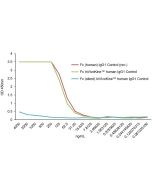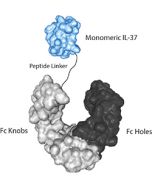Cookie Policy: This site uses cookies to improve your experience. You can find out more about our use of cookies in our Privacy Policy. By continuing to browse this site you agree to our use of cookies.
AdipoGen Life Sciences
IL-2 Superkine H9T (monomer):Fc InVivoKine™

| Product Details | |
|---|---|
| Synonyms | IL-2 Superkine H9T (monomer):Fc KIH (human) (rec.); Interleukin-2; T Cell Growth Factor; TCGF; Aldesleukin; Super-2 |
| Product Type | Protein |
| Properties | |
| Source/Host | HEK 293 cells. Produced using animal component-free medium. |
| Sequence |
The extracellular domain of human IL-2 (aa 21-153) (mutant H9T containing the mutations of H9: L80F / R81D / L85V / I 86V / I92F and the new mutation Q126T) is fused at the C-terminus to the Fc portion of human IgG1 (Knobs-into-Holes technology) (see reference: J.B. Ridgway, et al.; Protein Eng. 9, 617 (1996)). |
| Crossreactivity |
Human Mouse |
| Application |
Triggers greater antitumor responses by maintaining stem-cell memory phenotype of CD8+ T cells. |
| Specificity |
Binds to human and mouse IL-2R. |
| MW | ~45kDa and 28kDa (SDS-PAGE) |
| Purity | ≥95% (SDS-PAGE) |
| Endotoxin Content | <0.01EU/μg protein (LAL test). |
| Concentration |
After reconstitution: for 10µg size: 0.1mg/ml for 100µg size: 1mg/ml |
| Reconstitution | Reconstitute with 100μl endotoxin-free water. |
| Formulation | Lyophilized. Contains PBS. |
| Protein Negative Control | |
| Other Product Data |
Uniprot link P60568 : IL-2 (human) |
| Shipping and Handling | |
| Shipping | BLUE ICE |
| Short Term Storage | +4°C |
| Long Term Storage | -20°C |
| Handling Advice |
After reconstitution, prepare aliquots and store at -20°C. Avoid freeze/thaw cycles. Centrifuge lyophilized vial before opening and reconstitution. PBS containing at least 0.1% BSA should be used for further dilutions. |
| Use/Stability |
Stable for at least 6 months after receipt when stored at -20°C. Working aliquots are stable for up to 3 months when stored at -20°C. |
| Documents | |
| MSDS |
 Download PDF Download PDF |
| Product Specification Sheet | |
| Datasheet |
 Download PDF Download PDF |
Interleukin-2 (IL-2) is a 133 amino acid glycoprotein with one intramolecular disulfide bond and variable glycosylation. It is secreted by activated T cells and induces proliferation and maturation of activated T cells, natural killer cells and lymphokine activated killer cells. IL-2 also stimulates proliferation of antibody-producing B cells, activates neutrophils and induces mononuclear cells to secrete IFN-γ and TNF-α and -β. Moreover, studies have shown that IL-2 is required for activation-induced apoptosis, an important homeostatic mechanism in the immune system, which is involved in the maintenance of peripheral tolerance to self-antigens.
IL-2 promotes T cell proliferation and particularly naive T cells. IL-2 signaling on activated T cells is effected through a quaternary high-affinity receptor complex consisting of IL-2, IL-2Rα (CD25), IL-2Rβ and IL-2Rγ. Naive T cells are relatively insensitive to IL-2 as they only express small amounts of IL-2Rβ and IL-2Rγ. They only acquire sensitivity after CD25 expression, which captures the cytokine and presents it to the IL-2Rβ and IL-2Rγ receptors. IL-2 Superkine (Fc) is an artificial variant of IL-2 called H9, containing mutations at positions L80F / R81D / L85V / I 86V / I92F. These mutations are located in the molecule's core that acts to stabilize the structure and to give it a receptor-binding conformation mimicking native IL-2 bound to CD25. These mutations effectively eliminate the functional requirement of IL-2 for CD25 expression and elicit proliferation of T cells. Compared to IL-2, the IL-2 superkine induces superior expansion of cytotoxic T cells, leading to improved anti-tumor responses in vivo, and elicits proportionally less toxicity by lowering the expansion of T-regulatory cells and reducing pulmonary oedema.
A new version of IL-2 Superkine with a new additional mutation called H9T reduces the binding of IL-2Rγ and promotes the expansion of CD8+ T cells without driving terminal differentiation. TCR-transgenic and chimeric antigen receptor-modified CD8+ T cells that are expanded with H9T showed stronger anti-tumor activity in vivo in mouse models of melanoma and acute lymphoblastic leukemia. The new variant of IL-2 called H9T, helps to maintain activated CD8+ T cells in a stem-cell-like state, with greater anti-tumor activity in two mouse models. Like IL-2 Superkine (H9), IL-2 Superkine (H9T) also works on human T cells.
The IL-2 Superkine H9T (monomer):Fc InVivoKine™ is produced by using two different vectors, one encoding for the IL-2 Superkine H9T:Fc Knobs sequence (synthesizing a protein of 45kDa) and one encoding for the Fc Holes sequence (synthesizing a protein of 28kDa). Both vectors transfected into HEK293 cells produce both Fc molecules (Knobs-into-Holes technology; J.B. Ridgway, et al.; Protein Eng. 9, 617 (1996)) required for dimerization and for secretion of the final protein IL-2 Superkine H9T (monomer):Fc InVivoKine™.
InVivoKines™ are a new generation of recombinant fusion proteins for immunotherapeutic, preclinical and translational in vivo research, developed and manufactured by AdipoGen Life Sciences.
- An engineered IL-2 partial agonist promotes CD8+ T cell stemness: F. Mo, et al.; Nature 597, 544 (2021)









